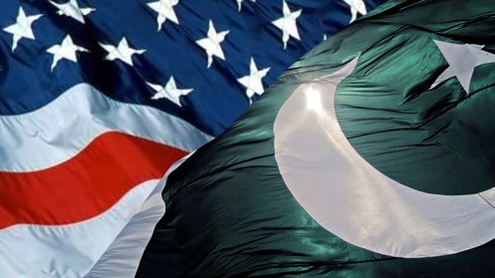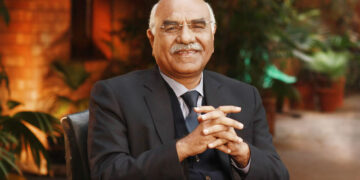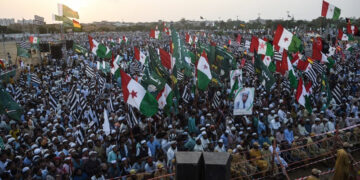 A relationship spanning over 65 years, both partners have sustained it, sometimes happily, other times not so happily. Many in the U.S.government and quite a number of independent analysts continue to express the view that U.S.
A relationship spanning over 65 years, both partners have sustained it, sometimes happily, other times not so happily. Many in the U.S.government and quite a number of independent analysts continue to express the view that U.S.
Strategic interests are inextricably linked with a stable Pakistan that can effectively implement the government’s writ to all of its territory and assist the United States with efforts to stabilize Afghanistan thereby contribute to the stability in the region. For America, on a deadline to move her combat forces out of Afghanistan, this is a crucial point. So much so, that according to a local report, “A diplomatic source revealed that Washington intended to shape its future relationship with Islamabad on the basis of latter’s approach towards Afghanistan, India and the region as a whole, in addition to its commitment to fighting terrorism at home.” (Published October 16, 2013) Whether or not America will be moving out is a debatable issue. Those opposing Pakistan have pointed out that Pakistan is a fragile state, ridden with deeply entrenched problems including life-threatening terrorism issues, dependence on foreign donors to keep the economy afloat, (Of the $5.1 billion in total aid committed for Pakistan in 2010, about 24% was from multilateral agencies and 76% from bilateral sources: US being the largest bilateral donor) corruption hurting rates of both domestic and foreign investments and lack of transparency leading to a lack of accountability to state a few.
US has tried to work its way around the problem of aid filtering to the grass root levels by channeling more money directly to Pakistani officials and local groups while scaling back use of US aid contractors. (USA Today, October 2, 2009) Energy shortage is one of the most bitingly crucial factor hurting the Pakistan economy. America had released a relief of much needed $16.5 million for the repairs of power grid. In mid-2012, Congress released $280 million in new assistance for Pakistan’s energy sector; these funds were to provide support for projects at Mangla and KurramTangi. (DAWN March 5, 2013) FATA a much ignored and backward area in Pakistan needs more educational institutions, better healthcare, more micro-investment and generally an improved quality of life for its people. “A senior USAID official estimated that, for FY2001-FY2007, about 6% of U.S. economic aid to Pakistan was allocated for projects in the FATA.” (Report: Susan B. Epstein&K. Alan Kronstadt July 1, 2013) President Dwight D. Eisenhower famously called Pakistan America’s “most allied ally in Asia. ”Lest we forget, it was Pakistan which allowed USA the use of Badaber air-base against the Soviets from 1958 onwards.
Yet, America’s aid has fluctuated to Pakistan in line with its foreign policy. To quote one example only; after the Soviet Army withdrew from Afghanistan in 1989 President George H. W. Bush suspended aid to Pakistan in 1990 because of its nuclear activities. “Unpredictability of U.S. aid has contributed to Pakistan’s view that the United States is an unreliable partner. That view may play a role in Pakistan’s level of cooperation with the United States on various national security issues while keeping its options open with U.S. competitors, such as China. The Pakistani Prime Minister’s May 2011 state visit to Beijing was viewed by many as an implicit response to a recent deterioration in U.S.-Pakistan ties.” (Published Associated Press, May 16, 2011) Post 9/11 era gave a new lease to the relationship with particular focus on security cooperation. US aid to Pakistan was restored resulting in Pakistan spearheading US anti-terror campaign. Pakistan became a pivotal ally to US in the war against terror.
American government does wonder why there is a feeling of anti-America in Pakistan in spite of all the aid. Very briefly stating, this too spans the period of relationship between the two nations, lack of US presence in the 1965 and 1971 wars Pakistan fought, unlike the all-out support given by USSR to India- also in terms of help to their ally ie $1 billion then, in military hardware aid within 2-3 months before the full escalation of war in East Pakistan. More recent incidents hurting Pakistan’s confidence in the relationship were of Raymond Davis and Dr Shakil Afridi, fueling anger and strengthening an opinion in Pakistanis, rightly or wrong, that US is a fair-weather friend. From USA’s point of view, Pakistan’s nuclear capability in a steaming political landscape is a threat to her security though Pakistan herself sees it as exactly opposite. US would like to stay neutral on Kashmir issue between India and Pakistan whereas it is a fact that this issue cannot be resolved by the disputed parties alone.
It was from 1951-53 that saw meetings between Pakistani and Indian counterparts at different high levels including the Prime Ministers about the Kashmir issue. Kashmir has been the cause of lingering postpartum pangs that have refused to go away. The post-op needs immediate attention if India and Pakistan are to behave as partners in regional stability and development. Issuing edicts for a desired action is not the answer. In the backdrop of friendships diverging on some fronts and converging on others; confidences and misgivings; the forthcoming visit of PM Sharif to USA is extremely important. The baggage of the relationship PM Nawaz carries with him is a heavy one but counterbalanced with this is the legitimacy of his government. A quality lacked by many of his predecessors who strengthened themselves at the cost of institutions. As a super power America has much to offer in form of expanded economic ties. PM Nawaz must expand the space of discussion to include trade cooperation and investment options besides security issues. It will be a tight rope PM Nawaz will be walking on.
A robust economy relies on conducive atmosphere not one riddled with security hazards, suicide bombings and terrorists running amok. US will be within its rights to be concerned about the security hazards. American concern will also be valid about not having much to show for civilian project funds poured in Pakistan’s economy over the years. Pakistan’s prime minister is also expected to bring up the question of drone attacks within its air space. Once again, this is a double edged sword and drone strategy can be justified by Obama’s administration in light of the presence of terrorist safe havens operating on its soil. Osama bin Laden’s presence under Islamabad’s nose being a case in point. Both the countries need introspection and an appreciation of the basic fact that on a lot of levels their interests may overlap and on others it may not. Both countries have an inherent right to look after their national interests. By the same token space must be given to allow the other partner to maneuver to watch out their own.
Pakistan is a more vulnerable partner in the relationship, its economy is struggling and terrorism has increased manifold owing to its initial acceptance to be America’s regional watch-dog. Pakistan will be around after US combat forces leave the neighboring shores. The geopolitical scenario is a complex one. But one thing is obvious; both the countries need each other more than ever before, particularly in light of Afghanistan stability where Pakistan can play a positive role. With this one point in focus, both countries must move together and ahead to face the challenges posed. Let us be reminded of Abraham Lincoln who said, “With Malice toward none, with charity for all, with firmness in the right, as God gives us to see the right, let us strive on to finish the work we are in, to bind up the nation’s wounds.” The writer is a lawyer, academic and political analyst. She has authored a book titled A Comparative Analysis of Media & Media Laws in Pakistan. -Nation












